
科学上网,也就是翻墙,是许多人的日常需求。无论是为了学习、工作、娱乐还是其他目的,我们都希望能够自由地访问互联网上的各种资源和信息。然而,由于某些原因,我们可能会遇到一些网络限制或干扰,导致我们无法正常地浏览网页或使用应用。这时候,我们就需要借助一些工具来突破这些限制,实现科学上网。
市面上有很多科学上网的工具玲琅满目,比如VPN、SSR、V2Ray等等。这些工具各有各的优缺点,但是它们都有一个共同的问题,就是需要付费。虽然有些工具也提供免费的服务或试用期,但是它们通常会有一些限制,比如流量、速度、稳定性等等。而且,这些工具也不一定安全可靠,有可能会泄露你的隐私或者被封锁。
那么,有没有一种方法可以实现免费、安全、稳定、快速的科学上网呢?答案是有的,那就是使用Cloudflare Workers。
Cloudflare Workers 是一个基于云端的平台,它可以让你在Cloudflare的边缘网络上运行JavaScript代码。你可以利用Cloudflare Workers来构建各种应用和服务,比如网站、API、聊天机器人等等。而且,Cloudflare Workers还有以下几个优势:
- 免费:Cloudflare Workers提供了一个免费套餐,每天可以免费运行10万次请求,对于个人使用来说已经足够了。
- 安全:Cloudflare Workers运行在沙盒环境中,不会影响其他用户或者服务器。而且,Cloudflare Workers使用HTTPS协议来加密传输数据,保护你的隐私和安全。
- 稳定:Cloudflare Workers运行在Cloudflare的全球分布式网络上,拥有超过200个数据中心。这意味着你可以随时随地访问Cloudflare Workers,并且不用担心它被封锁或者中断。
- 快速:Cloudflare Workers运行在离用户最近的数据中心上,减少了网络延迟和跳转。而且,Cloudflare Workers使用V8引擎来执行JavaScript代码,提高了执行效率和性能。
正是由于这些优势,Cloudflare Workers可以用来实现免费科学上网。具体来说,就是利用Cloudflare Workers作为一个反向代理,将你的请求转发到目标网站或者应用,并将响应返回给你。这样一来,你就可以绕过网络限制或者干扰,正常地访问互联网上的各种资源和信息。
那么,如何通过Cloudflare Workers创建免费科学上网呢?接下来,我将为你详细介绍这个过程,包括注册Cloudflare账号、创建Cloudflare Workers、编写JavaScript代码、部署和测试Cloudflare Workers等等。希望你能跟着我一步一步地操作,体验一下Cloudflare Workers的魅力。让我们开始吧!
一、搭建环境
- 一个cloudflare账号。不知道这么注册和解析域名的小伙伴请参考这篇文章【如何使用cloudflare来进行域名解析】
Cloudflare官网:https://www.cloudflare.com/ - 一个自己的域名(非必要)。没有域名的小伙伴请参考这两篇如何申请免费域名的文章【eu.org真正永久免费的域名】,【教你申请pp.ua免费域名】
- V2rayN代理软件。官方下载地址:https://github.com/2dust/v2rayN/releases
二、开始搭建
准备好cloudflare账号和域名后,我们现在就可以开始了。
1、首先,登录自己的cloudflare账号,点击 Workers和pages 选项。然后,在 概述 选项卡里,点击 创建应用程序 。
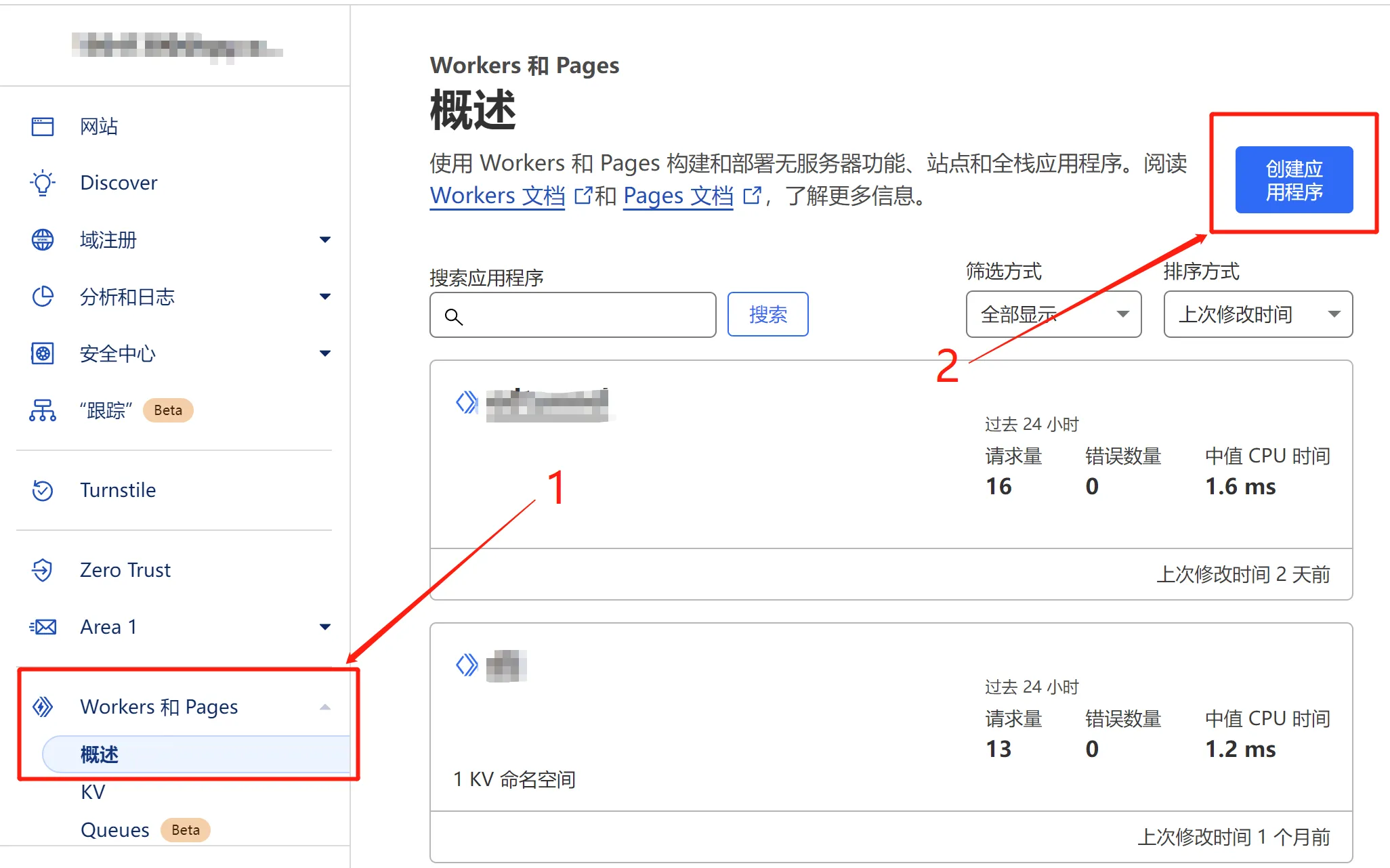
2、接下来,再点击 创建worker 。
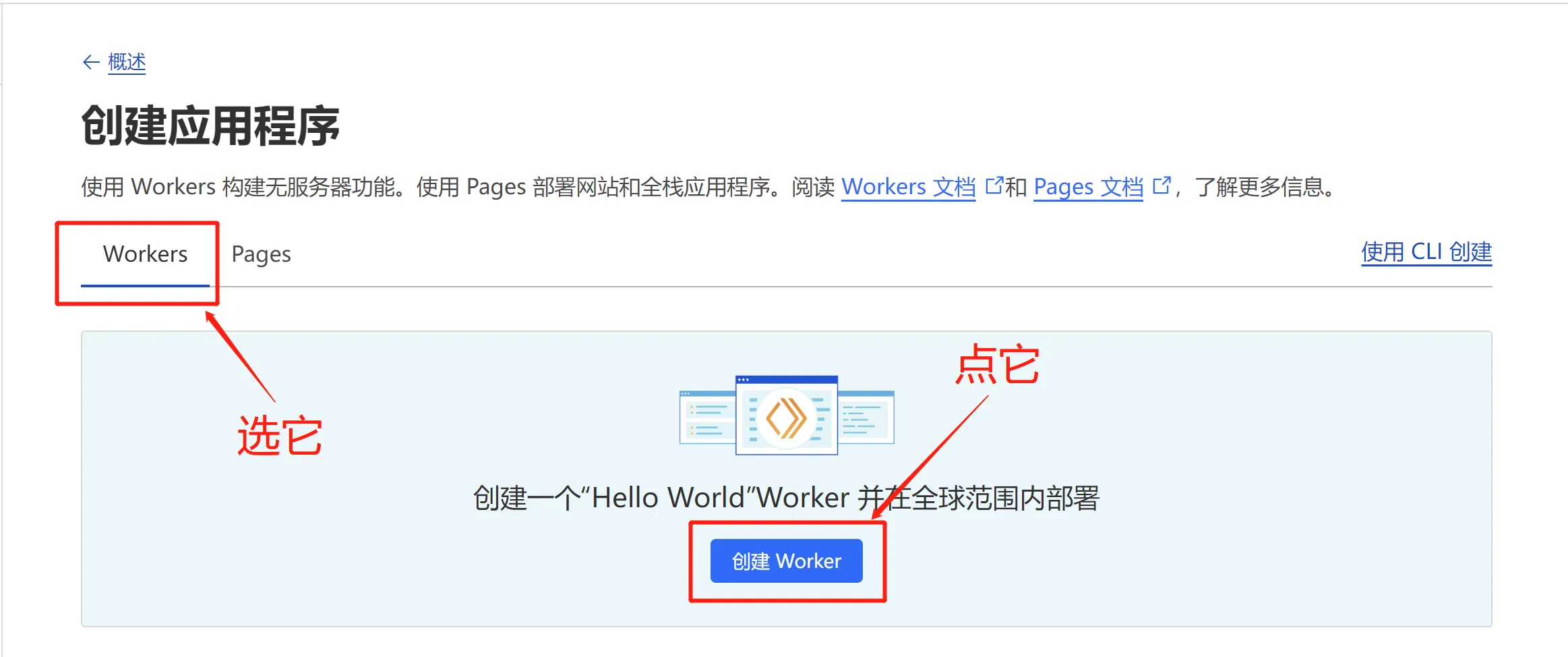
3、在这个界面我们可以在 名称 这里,为自己的项目起一个新名称,也可以默认自动为你创建好的名称,再点击 部署 。
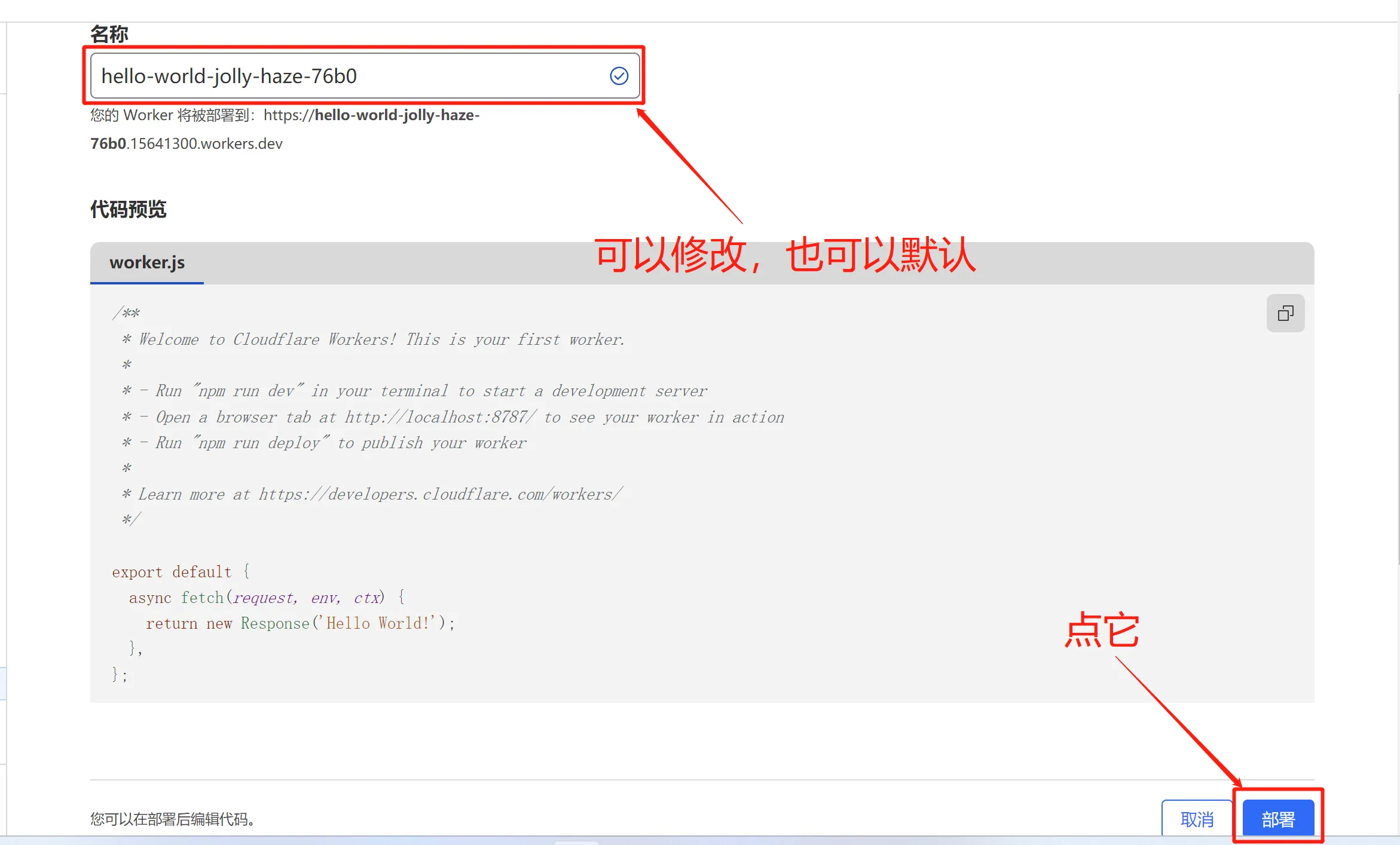
4、点击 编辑代码
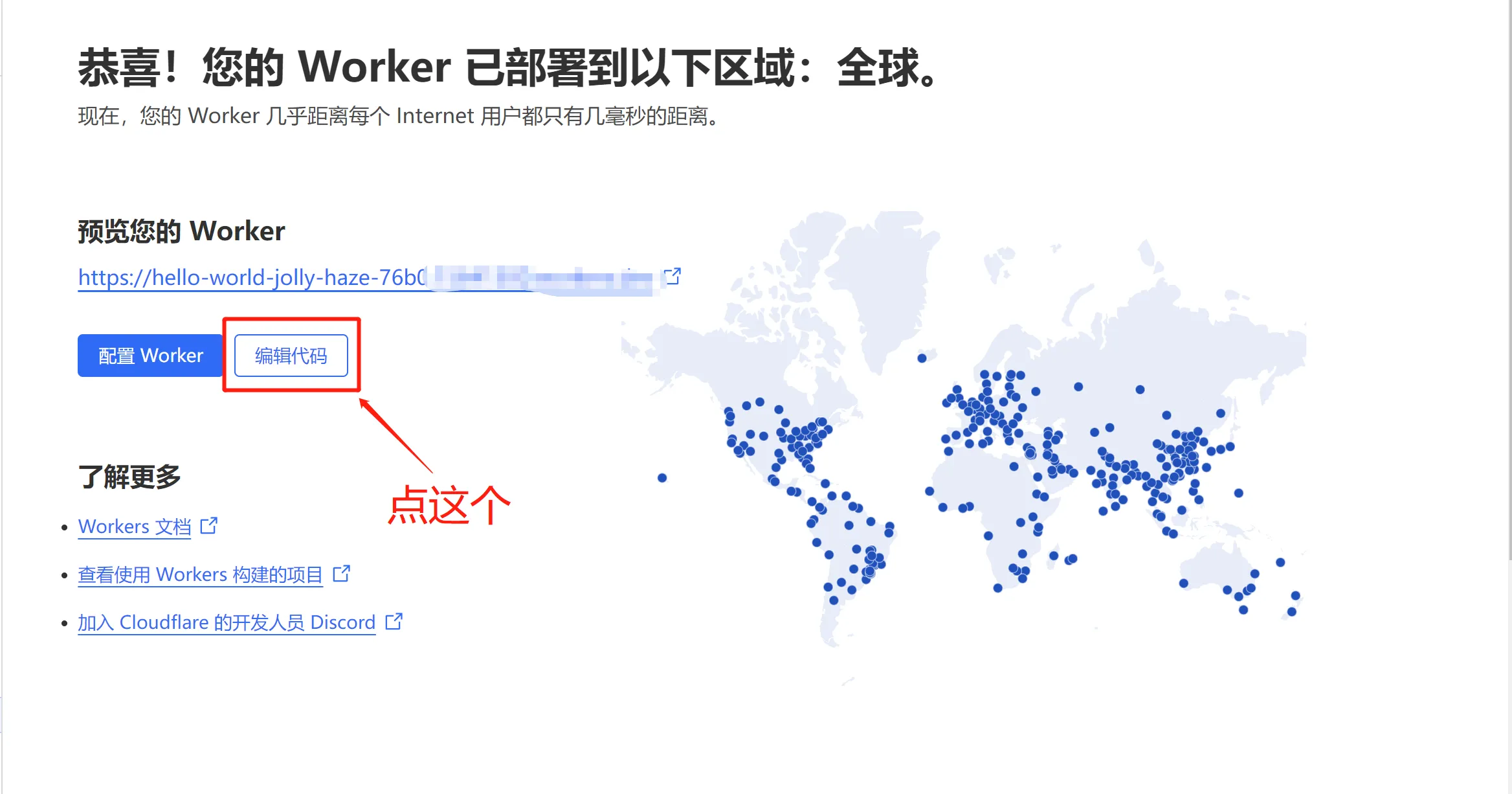
5、在这个界面,我们先将原有的代码清除,替换为下方我给到各位小伙伴的代码。
在这里有几个地方需要修改一下。第一,代码第7行单引号里的UUID要修改成自己的,没有的小伙伴可以到这里生成一个,将单引号里的内容替换成自己生成的就行了。其次,代码第104行这里是做一个伪装,甬哥用的是CCTV国际站的网址,你也可以修改为其他的网址,我就喜欢用特斯拉国际站的地址。第三,第9行,IP可以用作者在后边注释的服务器地址,也可以自己优选反代IP,这里是涉及到反代的操作,先不细讲,下一篇文章我们再讲。
做完所有操作之后,点击 保存并部署 ,这样,我们就成功搭建好了自己的免费节点,只需要运用工具就能实现科学上网了。
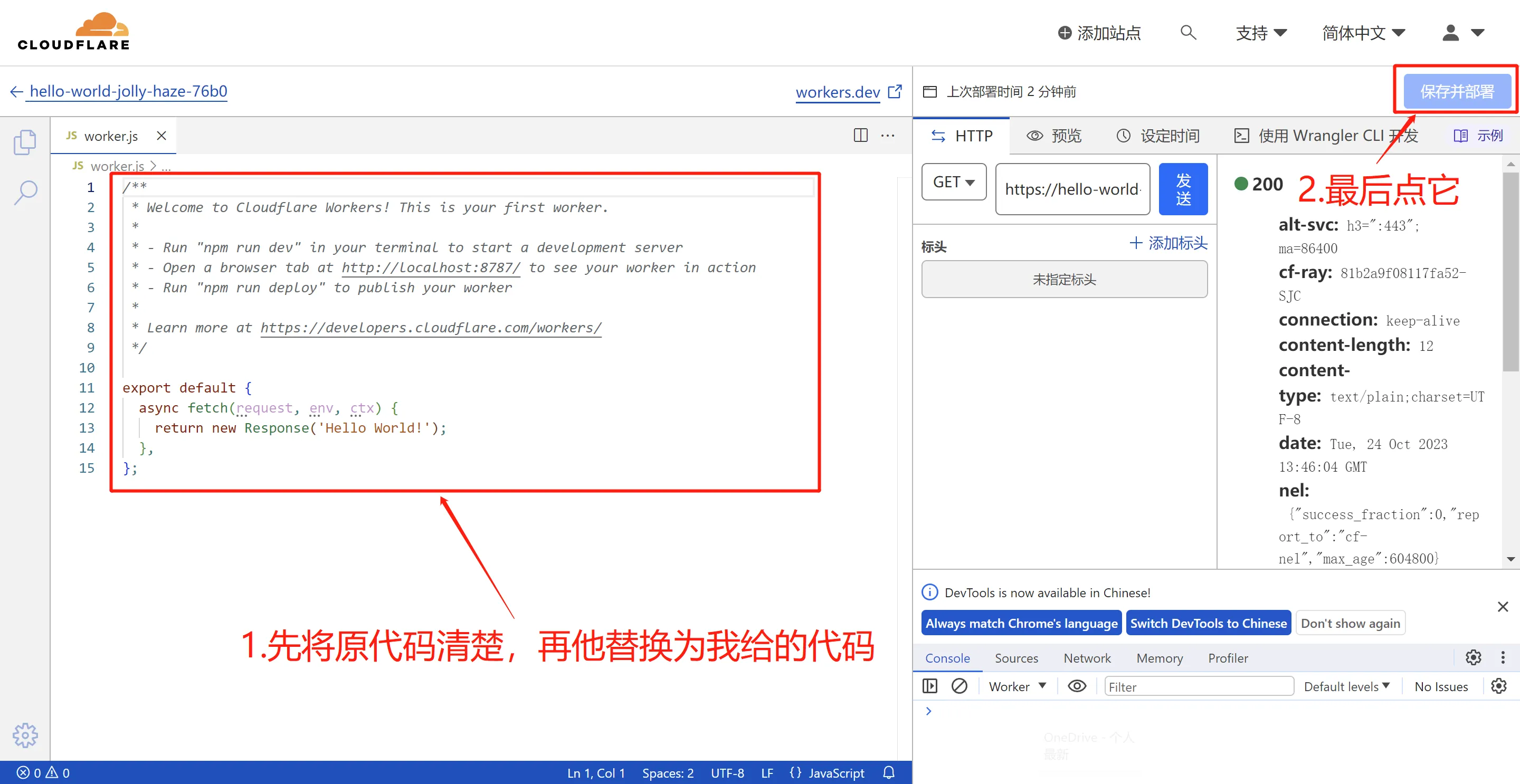
项目地址:https://github.com/yonggekkk/Cloudflare-workers-pages-vless/blob/main/_worker.js
这里我就用甬哥大佬的代码,还请大家多多关注甬哥、支持甬哥。
// <!--GAMFC-->version base on commit 43fad05dcdae3b723c53c226f8181fc5bd47223e, time is 2023-06-22 15:20:02 UTC<!--GAMFC-END-->.
// @ts-ignore
import { connect } from 'cloudflare:sockets';
// How to generate your own UUID:
// [Windows] Press "Win + R", input cmd and run: Powershell -NoExit -Command "[guid]::NewGuid()"
let userID = '77a571fb-4fd2-4b37-8596-1b7d9728bb5c';
const proxyIPs = ["cdn.xn--b6gac.eu.org"]; //workers.cloudflare.cyou bestproxy.onecf.eu.org cdn-all.xn--b6gac.eu.org cdn.xn--b6gac.eu.org
let proxyIP = proxyIPs[Math.floor(Math.random() * proxyIPs.length)];
let dohURL = 'https://sky.rethinkdns.com/1:-Pf_____9_8A_AMAIgE8kMABVDDmKOHTAKg='; // https://cloudflare-dns.com/dns-query or https://dns.google/dns-query
// v2board api environment variables (optional) deprecated, please use planetscale.com instead
if (!isValidUUID(userID)) {
throw new Error('uuid is invalid');
}
export default {
/**
* @param {import("@cloudflare/workers-types").Request} request
* @param {{UUID: string, PROXYIP: string, DNS_RESOLVER_URL: string, NODE_ID: int, API_HOST: string, API_TOKEN: string}} env
* @param {import("@cloudflare/workers-types").ExecutionContext} ctx
* @returns {Promise<Response>}
*/
async fetch(request, env, ctx) {
// uuid_validator(request);
try {
userID = env.UUID || userID;
proxyIP = env.PROXYIP || proxyIP;
dohURL = env.DNS_RESOLVER_URL || dohURL;
let userID_Path = userID;
if (userID.includes(',')) {
userID_Path = userID.split(',')[0];
}
const upgradeHeader = request.headers.get('Upgrade');
if (!upgradeHeader || upgradeHeader !== 'websocket') {
const url = new URL(request.url);
switch (url.pathname) {
case '/cf':
return new Response(JSON.stringify(request.cf, null, 4), {
status: 200,
headers: {
"Content-Type": "application/json;charset=utf-8",
},
});
case `/${userID_Path}`: {
const vlessConfig = getVLESSConfig(userID, request.headers.get('Host'));
return new Response(`${vlessConfig}`, {
status: 200,
headers: {
"Content-Type": "text/html; charset=utf-8",
}
});
}
case `/sub/${userID_Path}`: {
const url = new URL(request.url);
const searchParams = url.searchParams;
let vlessConfig = createVLESSSub(userID, request.headers.get('Host'));
// If 'format' query param equals to 'clash', convert config to base64
if (searchParams.get('format') === 'clash') {
vlessConfig = btoa(vlessConfig);
}
// Construct and return response object
return new Response(vlessConfig, {
status: 200,
headers: {
"Content-Type": "text/plain;charset=utf-8",
}
});
}
case `/bestip/${userID_Path}`: {
const bestiplink = `https://sub.xf.free.hr/auto?host=${request.headers.get('Host')}&uuid=${userID_Path}`
const reqHeaders = new Headers(request.headers);
const bestipresponse = await fetch(bestiplink, { redirect: 'manual', headers: reqHeaders, });
// Construct and return response object
return bestipresponse
}
default:
// return new Response('Not found', { status: 404 });
// For any other path, reverse proxy to 'www.fmprc.gov.cn' and return the original response, caching it in the process
const hostnames = ['www.fmprc.gov.cn', 'www.xuexi.cn', 'www.gov.cn', 'mail.gov.cn', 'www.mofcom.gov.cn', 'www.gfbzb.gov.cn', 'www.miit.gov.cn', 'www.12377.cn'];
url.hostname = hostnames[Math.floor(Math.random() * hostnames.length)];
url.protocol = 'https:';
const newHeaders = new Headers(request.headers);
newHeaders.set('cf-connecting-ip', newHeaders.get('x-forwarded-for') || newHeaders.get('cf-connecting-ip'));
newHeaders.set('x-forwarded-for', newHeaders.get('cf-connecting-ip'));
newHeaders.set('x-real-ip', newHeaders.get('cf-connecting-ip'));
newHeaders.set('referer', 'https://www.google.com/q=edtunnel');
request = new Request(url, {
method: request.method,
headers: newHeaders,
body: request.body,
redirect: request.redirect,
});
const cache = caches.default;
let response = await cache.match(request);
if (!response) {
try {
response = await fetch(request, { redirect: 'manual' });
} catch (err) {
url.protocol = 'http:';
url.hostname = hostnames[Math.floor(Math.random() * hostnames.length)];
request = new Request(url, {
method: request.method,
headers: newHeaders,
body: request.body,
redirect: request.redirect,
});
response = await fetch(request, { redirect: 'manual' });
}
const cloneResponse = response.clone();
ctx.waitUntil(cache.put(request, cloneResponse));
}
return response;
}
} else {
return await vlessOverWSHandler(request);
}
} catch (err) {
/** @type {Error} */ let e = err;
return new Response(e.toString());
}
},
};
export async function uuid_validator(request) {
const hostname = request.headers.get('Host');
const currentDate = new Date();
const subdomain = hostname.split('.')[0];
const year = currentDate.getFullYear();
const month = String(currentDate.getMonth() + 1).padStart(2, '0');
const day = String(currentDate.getDate()).padStart(2, '0');
const formattedDate = `${year}-${month}-${day}`;
// const daliy_sub = formattedDate + subdomain
const hashHex = await hashHex_f(subdomain);
// subdomain string contains timestamps utc and uuid string TODO.
console.log(hashHex, subdomain, formattedDate);
}
export async function hashHex_f(string) {
const encoder = new TextEncoder();
const data = encoder.encode(string);
const hashBuffer = await crypto.subtle.digest('SHA-256', data);
const hashArray = Array.from(new Uint8Array(hashBuffer));
const hashHex = hashArray.map(byte => byte.toString(16).padStart(2, '0')).join('');
return hashHex;
}
/**
* Handles VLESS over WebSocket requests by creating a WebSocket pair, accepting the WebSocket connection, and processing the VLESS header.
* @param {import("@cloudflare/workers-types").Request} request The incoming request object.
* @returns {Promise<Response>} A Promise that resolves to a WebSocket response object.
*/
async function vlessOverWSHandler(request) {
const webSocketPair = new WebSocketPair();
const [client, webSocket] = Object.values(webSocketPair);
webSocket.accept();
let address = '';
let portWithRandomLog = '';
let currentDate = new Date();
const log = (/** @type {string} */ info, /** @type {string | undefined} */ event) => {
console.log(`[${currentDate} ${address}:${portWithRandomLog}] ${info}`, event || '');
};
const earlyDataHeader = request.headers.get('sec-websocket-protocol') || '';
const readableWebSocketStream = makeReadableWebSocketStream(webSocket, earlyDataHeader, log);
/** @type {{ value: import("@cloudflare/workers-types").Socket | null}}*/
let remoteSocketWapper = {
value: null,
};
let udpStreamWrite = null;
let isDns = false;
// ws --> remote
readableWebSocketStream.pipeTo(new WritableStream({
async write(chunk, controller) {
if (isDns && udpStreamWrite) {
return udpStreamWrite(chunk);
}
if (remoteSocketWapper.value) {
const writer = remoteSocketWapper.value.writable.getWriter()
await writer.write(chunk);
writer.releaseLock();
return;
}
const {
hasError,
message,
portRemote = 443,
addressRemote = '',
rawDataIndex,
vlessVersion = new Uint8Array([0, 0]),
isUDP,
} = processVlessHeader(chunk, userID);
address = addressRemote;
portWithRandomLog = `${portRemote} ${isUDP ? 'udp' : 'tcp'} `;
if (hasError) {
// controller.error(message);
throw new Error(message); // cf seems has bug, controller.error will not end stream
// webSocket.close(1000, message);
return;
}
// If UDP and not DNS port, close it
if (isUDP && portRemote !== 53) {
throw new Error('UDP proxy only enabled for DNS which is port 53');
// cf seems has bug, controller.error will not end stream
}
if (isUDP && portRemote === 53) {
isDns = true;
}
// ["version", "附加信息长度 N"]
const vlessResponseHeader = new Uint8Array([vlessVersion[0], 0]);
const rawClientData = chunk.slice(rawDataIndex);
// TODO: support udp here when cf runtime has udp support
if (isDns) {
const { write } = await handleUDPOutBound(webSocket, vlessResponseHeader, log);
udpStreamWrite = write;
udpStreamWrite(rawClientData);
return;
}
handleTCPOutBound(remoteSocketWapper, addressRemote, portRemote, rawClientData, webSocket, vlessResponseHeader, log);
},
close() {
log(`readableWebSocketStream is close`);
},
abort(reason) {
log(`readableWebSocketStream is abort`, JSON.stringify(reason));
},
})).catch((err) => {
log('readableWebSocketStream pipeTo error', err);
});
return new Response(null, {
status: 101,
webSocket: client,
});
}
/**
* Handles outbound TCP connections.
*
* @param {any} remoteSocket
* @param {string} addressRemote The remote address to connect to.
* @param {number} portRemote The remote port to connect to.
* @param {Uint8Array} rawClientData The raw client data to write.
* @param {import("@cloudflare/workers-types").WebSocket} webSocket The WebSocket to pass the remote socket to.
* @param {Uint8Array} vlessResponseHeader The VLESS response header.
* @param {function} log The logging function.
* @returns {Promise<void>} The remote socket.
*/
async function handleTCPOutBound(remoteSocket, addressRemote, portRemote, rawClientData, webSocket, vlessResponseHeader, log,) {
/**
* Connects to a given address and port and writes data to the socket.
* @param {string} address The address to connect to.
* @param {number} port The port to connect to.
* @returns {Promise<import("@cloudflare/workers-types").Socket>} A Promise that resolves to the connected socket.
*/
async function connectAndWrite(address, port) {
/** @type {import("@cloudflare/workers-types").Socket} */
const tcpSocket = connect({
hostname: address,
port: port,
});
remoteSocket.value = tcpSocket;
log(`connected to ${address}:${port}`);
const writer = tcpSocket.writable.getWriter();
await writer.write(rawClientData); // first write, nomal is tls client hello
writer.releaseLock();
return tcpSocket;
}
/**
* Retries connecting to the remote address and port if the Cloudflare socket has no incoming data.
* @returns {Promise<void>} A Promise that resolves when the retry is complete.
*/
async function retry() {
const tcpSocket = await connectAndWrite(proxyIP || addressRemote, portRemote)
tcpSocket.closed.catch(error => {
console.log('retry tcpSocket closed error', error);
}).finally(() => {
safeCloseWebSocket(webSocket);
})
remoteSocketToWS(tcpSocket, webSocket, vlessResponseHeader, null, log);
}
const tcpSocket = await connectAndWrite(addressRemote, portRemote);
// when remoteSocket is ready, pass to websocket
// remote--> ws
remoteSocketToWS(tcpSocket, webSocket, vlessResponseHeader, retry, log);
}
/**
* Creates a readable stream from a WebSocket server, allowing for data to be read from the WebSocket.
* @param {import("@cloudflare/workers-types").WebSocket} webSocketServer The WebSocket server to create the readable stream from.
* @param {string} earlyDataHeader The header containing early data for WebSocket 0-RTT.
* @param {(info: string)=> void} log The logging function.
* @returns {ReadableStream} A readable stream that can be used to read data from the WebSocket.
*/
function makeReadableWebSocketStream(webSocketServer, earlyDataHeader, log) {
let readableStreamCancel = false;
const stream = new ReadableStream({
start(controller) {
webSocketServer.addEventListener('message', (event) => {
const message = event.data;
controller.enqueue(message);
});
webSocketServer.addEventListener('close', () => {
safeCloseWebSocket(webSocketServer);
controller.close();
});
webSocketServer.addEventListener('error', (err) => {
log('webSocketServer has error');
controller.error(err);
});
const { earlyData, error } = base64ToArrayBuffer(earlyDataHeader);
if (error) {
controller.error(error);
} else if (earlyData) {
controller.enqueue(earlyData);
}
},
pull(controller) {
// if ws can stop read if stream is full, we can implement backpressure
// https://streams.spec.whatwg.org/#example-rs-push-backpressure
},
cancel(reason) {
log(`ReadableStream was canceled, due to ${reason}`)
readableStreamCancel = true;
safeCloseWebSocket(webSocketServer);
}
});
return stream;
}
// https://xtls.github.io/development/protocols/vless.html
// https://github.com/zizifn/excalidraw-backup/blob/main/v2ray-protocol.excalidraw
/**
* Processes the VLESS header buffer and returns an object with the relevant information.
* @param {ArrayBuffer} vlessBuffer The VLESS header buffer to process.
* @param {string} userID The user ID to validate against the UUID in the VLESS header.
* @returns {{
* hasError: boolean,
* message?: string,
* addressRemote?: string,
* addressType?: number,
* portRemote?: number,
* rawDataIndex?: number,
* vlessVersion?: Uint8Array,
* isUDP?: boolean
* }} An object with the relevant information extracted from the VLESS header buffer.
*/
function processVlessHeader(vlessBuffer, userID) {
if (vlessBuffer.byteLength < 24) {
return {
hasError: true,
message: 'invalid data',
};
}
const version = new Uint8Array(vlessBuffer.slice(0, 1));
let isValidUser = false;
let isUDP = false;
const slicedBuffer = new Uint8Array(vlessBuffer.slice(1, 17));
const slicedBufferString = stringify(slicedBuffer);
// check if userID is valid uuid or uuids split by , and contains userID in it otherwise return error message to console
const uuids = userID.includes(',') ? userID.split(",") : [userID];
// uuid_validator(hostName, slicedBufferString);
// isValidUser = uuids.some(userUuid => slicedBufferString === userUuid.trim());
isValidUser = uuids.some(userUuid => slicedBufferString === userUuid.trim()) || uuids.length === 1 && slicedBufferString === uuids[0].trim();
console.log(`userID: ${slicedBufferString}`);
if (!isValidUser) {
return {
hasError: true,
message: 'invalid user',
};
}
const optLength = new Uint8Array(vlessBuffer.slice(17, 18))[0];
//skip opt for now
const command = new Uint8Array(
vlessBuffer.slice(18 + optLength, 18 + optLength + 1)
)[0];
// 0x01 TCP
// 0x02 UDP
// 0x03 MUX
if (command === 1) {
isUDP = false;
} else if (command === 2) {
isUDP = true;
} else {
return {
hasError: true,
message: `command ${command} is not support, command 01-tcp,02-udp,03-mux`,
};
}
const portIndex = 18 + optLength + 1;
const portBuffer = vlessBuffer.slice(portIndex, portIndex + 2);
// port is big-Endian in raw data etc 80 == 0x005d
const portRemote = new DataView(portBuffer).getUint16(0);
let addressIndex = portIndex + 2;
const addressBuffer = new Uint8Array(
vlessBuffer.slice(addressIndex, addressIndex + 1)
);
// 1--> ipv4 addressLength =4
// 2--> domain name addressLength=addressBuffer[1]
// 3--> ipv6 addressLength =16
const addressType = addressBuffer[0];
let addressLength = 0;
let addressValueIndex = addressIndex + 1;
let addressValue = '';
switch (addressType) {
case 1:
addressLength = 4;
addressValue = new Uint8Array(
vlessBuffer.slice(addressValueIndex, addressValueIndex + addressLength)
).join('.');
break;
case 2:
addressLength = new Uint8Array(
vlessBuffer.slice(addressValueIndex, addressValueIndex + 1)
)[0];
addressValueIndex += 1;
addressValue = new TextDecoder().decode(
vlessBuffer.slice(addressValueIndex, addressValueIndex + addressLength)
);
break;
case 3:
addressLength = 16;
const dataView = new DataView(
vlessBuffer.slice(addressValueIndex, addressValueIndex + addressLength)
);
// 2001:0db8:85a3:0000:0000:8a2e:0370:7334
const ipv6 = [];
for (let i = 0; i < 8; i++) {
ipv6.push(dataView.getUint16(i * 2).toString(16));
}
addressValue = ipv6.join(':');
// seems no need add [] for ipv6
break;
default:
return {
hasError: true,
message: `invild addressType is ${addressType}`,
};
}
if (!addressValue) {
return {
hasError: true,
message: `addressValue is empty, addressType is ${addressType}`,
};
}
return {
hasError: false,
addressRemote: addressValue,
addressType,
portRemote,
rawDataIndex: addressValueIndex + addressLength,
vlessVersion: version,
isUDP,
};
}
/**
* Converts a remote socket to a WebSocket connection.
* @param {import("@cloudflare/workers-types").Socket} remoteSocket The remote socket to convert.
* @param {import("@cloudflare/workers-types").WebSocket} webSocket The WebSocket to connect to.
* @param {ArrayBuffer | null} vlessResponseHeader The VLESS response header.
* @param {(() => Promise<void>) | null} retry The function to retry the connection if it fails.
* @param {(info: string) => void} log The logging function.
* @returns {Promise<void>} A Promise that resolves when the conversion is complete.
*/
async function remoteSocketToWS(remoteSocket, webSocket, vlessResponseHeader, retry, log) {
// remote--> ws
let remoteChunkCount = 0;
let chunks = [];
/** @type {ArrayBuffer | null} */
let vlessHeader = vlessResponseHeader;
let hasIncomingData = false; // check if remoteSocket has incoming data
await remoteSocket.readable
.pipeTo(
new WritableStream({
start() {
},
/**
*
* @param {Uint8Array} chunk
* @param {*} controller
*/
async write(chunk, controller) {
hasIncomingData = true;
remoteChunkCount++;
if (webSocket.readyState !== WS_READY_STATE_OPEN) {
controller.error(
'webSocket.readyState is not open, maybe close'
);
}
if (vlessHeader) {
webSocket.send(await new Blob([vlessHeader, chunk]).arrayBuffer());
vlessHeader = null;
} else {
// console.log(`remoteSocketToWS send chunk ${chunk.byteLength}`);
// seems no need rate limit this, CF seems fix this??..
// if (remoteChunkCount > 20000) {
// // cf one package is 4096 byte(4kb), 4096 * 20000 = 80M
// await delay(1);
// }
webSocket.send(chunk);
}
},
close() {
log(`remoteConnection!.readable is close with hasIncomingData is ${hasIncomingData}`);
// safeCloseWebSocket(webSocket); // no need server close websocket frist for some case will casue HTTP ERR_CONTENT_LENGTH_MISMATCH issue, client will send close event anyway.
},
abort(reason) {
console.error(`remoteConnection!.readable abort`, reason);
},
})
)
.catch((error) => {
console.error(
`remoteSocketToWS has exception `,
error.stack || error
);
safeCloseWebSocket(webSocket);
});
// seems is cf connect socket have error,
// 1. Socket.closed will have error
// 2. Socket.readable will be close without any data coming
if (hasIncomingData === false && retry) {
log(`retry`)
retry();
}
}
/**
* Decodes a base64 string into an ArrayBuffer.
* @param {string} base64Str The base64 string to decode.
* @returns {{earlyData: ArrayBuffer|null, error: Error|null}} An object containing the decoded ArrayBuffer or null if there was an error, and any error that occurred during decoding or null if there was no error.
*/
function base64ToArrayBuffer(base64Str) {
if (!base64Str) {
return { earlyData: null, error: null };
}
try {
// go use modified Base64 for URL rfc4648 which js atob not support
base64Str = base64Str.replace(/-/g, '+').replace(/_/g, '/');
const decode = atob(base64Str);
const arryBuffer = Uint8Array.from(decode, (c) => c.charCodeAt(0));
return { earlyData: arryBuffer.buffer, error: null };
} catch (error) {
return { earlyData: null, error };
}
}
/**
* Checks if a given string is a valid UUID.
* Note: This is not a real UUID validation.
* @param {string} uuid The string to validate as a UUID.
* @returns {boolean} True if the string is a valid UUID, false otherwise.
*/
function isValidUUID(uuid) {
const uuidRegex = /^[0-9a-f]{8}-[0-9a-f]{4}-[4][0-9a-f]{3}-[89ab][0-9a-f]{3}-[0-9a-f]{12}$/i;
return uuidRegex.test(uuid);
}
const WS_READY_STATE_OPEN = 1;
const WS_READY_STATE_CLOSING = 2;
/**
* Closes a WebSocket connection safely without throwing exceptions.
* @param {import("@cloudflare/workers-types").WebSocket} socket The WebSocket connection to close.
*/
function safeCloseWebSocket(socket) {
try {
if (socket.readyState === WS_READY_STATE_OPEN || socket.readyState === WS_READY_STATE_CLOSING) {
socket.close();
}
} catch (error) {
console.error('safeCloseWebSocket error', error);
}
}
const byteToHex = [];
for (let i = 0; i < 256; ++i) {
byteToHex.push((i + 256).toString(16).slice(1));
}
function unsafeStringify(arr, offset = 0) {
return (byteToHex[arr[offset + 0]] + byteToHex[arr[offset + 1]] + byteToHex[arr[offset + 2]] + byteToHex[arr[offset + 3]] + "-" + byteToHex[arr[offset + 4]] + byteToHex[arr[offset + 5]] + "-" + byteToHex[arr[offset + 6]] + byteToHex[arr[offset + 7]] + "-" + byteToHex[arr[offset + 8]] + byteToHex[arr[offset + 9]] + "-" + byteToHex[arr[offset + 10]] + byteToHex[arr[offset + 11]] + byteToHex[arr[offset + 12]] + byteToHex[arr[offset + 13]] + byteToHex[arr[offset + 14]] + byteToHex[arr[offset + 15]]).toLowerCase();
}
function stringify(arr, offset = 0) {
const uuid = unsafeStringify(arr, offset);
if (!isValidUUID(uuid)) {
throw TypeError("Stringified UUID is invalid");
}
return uuid;
}
/**
* Handles outbound UDP traffic by transforming the data into DNS queries and sending them over a WebSocket connection.
* @param {import("@cloudflare/workers-types").WebSocket} webSocket The WebSocket connection to send the DNS queries over.
* @param {ArrayBuffer} vlessResponseHeader The VLESS response header.
* @param {(string) => void} log The logging function.
* @returns {{write: (chunk: Uint8Array) => void}} An object with a write method that accepts a Uint8Array chunk to write to the transform stream.
*/
async function handleUDPOutBound(webSocket, vlessResponseHeader, log) {
let isVlessHeaderSent = false;
const transformStream = new TransformStream({
start(controller) {
},
transform(chunk, controller) {
// udp message 2 byte is the the length of udp data
// TODO: this should have bug, beacsue maybe udp chunk can be in two websocket message
for (let index = 0; index < chunk.byteLength;) {
const lengthBuffer = chunk.slice(index, index + 2);
const udpPakcetLength = new DataView(lengthBuffer).getUint16(0);
const udpData = new Uint8Array(
chunk.slice(index + 2, index + 2 + udpPakcetLength)
);
index = index + 2 + udpPakcetLength;
controller.enqueue(udpData);
}
},
flush(controller) {
}
});
// only handle dns udp for now
transformStream.readable.pipeTo(new WritableStream({
async write(chunk) {
const resp = await fetch(dohURL, // dns server url
{
method: 'POST',
headers: {
'content-type': 'application/dns-message',
},
body: chunk,
})
const dnsQueryResult = await resp.arrayBuffer();
const udpSize = dnsQueryResult.byteLength;
// console.log([...new Uint8Array(dnsQueryResult)].map((x) => x.toString(16)));
const udpSizeBuffer = new Uint8Array([(udpSize >> 8) & 0xff, udpSize & 0xff]);
if (webSocket.readyState === WS_READY_STATE_OPEN) {
log(`doh success and dns message length is ${udpSize}`);
if (isVlessHeaderSent) {
webSocket.send(await new Blob([udpSizeBuffer, dnsQueryResult]).arrayBuffer());
} else {
webSocket.send(await new Blob([vlessResponseHeader, udpSizeBuffer, dnsQueryResult]).arrayBuffer());
isVlessHeaderSent = true;
}
}
}
})).catch((error) => {
log('dns udp has error' + error)
});
const writer = transformStream.writable.getWriter();
return {
/**
*
* @param {Uint8Array} chunk
*/
write(chunk) {
writer.write(chunk);
}
};
}
/**
*
* @param {string} userID - single or comma separated userIDs
* @param {string | null} hostName
* @returns {string}
*/
function getVLESSConfig(userIDs, hostName) {
const commonUrlPart = `:443?encryption=none&security=tls&sni=${hostName}&fp=randomized&type=ws&host=${hostName}&path=%2F%3Fed%3D2048#${hostName}`;
const separator = "---------------------------------------------------------------";
const hashSeparator = "################################################################";
// Split the userIDs into an array
let userIDArray = userIDs.split(',');
// Prepare output array
let output = [];
let header = [];
const clash_link = `https://subconverter.do.xn--b6gac.eu.org/sub?target=clash&url=https://${hostName}/sub/${userIDArray[0]}?format=clash&insert=false&emoji=true&list=false&tfo=false&scv=true&fdn=false&sort=false&new_name=true`;
header.push(`\n<p align="center"><img src="https://cloudflare-ipfs.com/ipfs/bafybeigd6i5aavwpr6wvnwuyayklq3omonggta4x2q7kpmgafj357nkcky" alt="图片描述" style="margin-bottom: -50px;">`);
header.push(`\n<b style=" font-size: 15px;" >Welcome! This function generates configuration for VLESS protocol. If you found this useful, please check our GitHub project for more:</b>\n`);
header.push(`<b style=" font-size: 15px;" >欢迎!这是生成 VLESS 协议的配置。如果您发现这个项目很好用,请查看我们的 GitHub 项目给我一个star:</b>\n`);
header.push(`\n<a href="https://github.com/3Kmfi6HP/EDtunnel" target="_blank">EDtunnel - https://github.com/3Kmfi6HP/EDtunnel</a>\n`);
header.push(`\n<iframe src="https://ghbtns.com/github-btn.html?user=USERNAME&repo=REPOSITORY&type=star&count=true&size=large" frameborder="0" scrolling="0" width="170" height="30" title="GitHub"></iframe>\n\n`.replace(/USERNAME/g, "3Kmfi6HP").replace(/REPOSITORY/g, "EDtunnel"));
header.push(`<a href="//${hostName}/sub/${userIDArray[0]}" target="_blank">VLESS 节点订阅连接</a>\n<a href="clash://install-config?url=${encodeURIComponent(clash_link)}" target="_blank">Clash 节点订阅连接</a>\n<a href="${clash_link}" target="_blank">Clash 节点订阅连接2</a></p>\n`);
header.push(``);
// Generate output string for each userID
userIDArray.forEach((userID) => {
const vlessMain = `vless://${userID}@${hostName}${commonUrlPart}`;
const vlessSec = `vless://${userID}@${proxyIP}${commonUrlPart}`;
output.push(`UUID: ${userID}`);
output.push(`${hashSeparator}\nv2ray default ip\n${separator}\n${vlessMain}\n${separator}`);
output.push(`${hashSeparator}\nv2ray with best ip\n${separator}\n${vlessSec}\n${separator}`);
});
output.push(`${hashSeparator}\n# Clash Proxy Provider 配置格式(configuration format)\nproxy-groups:\n - name: UseProvider\n type: select\n use:\n - provider1\n proxies:\n - Proxy\n - DIRECT\nproxy-providers:\n provider1:\n type: http\n url: https://${hostName}/sub/${userIDArray[0]}?format=clash\n interval: 3600\n path: ./provider1.yaml\n health-check:\n enable: true\n interval: 600\n # lazy: true\n url: http://www.gstatic.com/generate_204\n\n${hashSeparator}`);
// HTML Head with CSS
const htmlHead = `
<head>
<title>EDtunnel: VLESS configuration</title>
<meta name="description" content="This is a tool for generating VLESS protocol configurations. Give us a star on GitHub https://github.com/3Kmfi6HP/EDtunnel if you found it useful!">
<meta name="keywords" content="EDtunnel, cloudflare pages, cloudflare worker, severless">
<meta name="viewport" content="width=device-width, initial-scale=1">
<meta property="og:site_name" content="EDtunnel: VLESS configuration" />
<meta property="og:type" content="website" />
<meta property="og:title" content="EDtunnel - VLESS configuration and subscribe output" />
<meta property="og:description" content="Use cloudflare pages and worker severless to implement vless protocol" />
<meta property="og:url" content="https://${hostName}/" />
<meta property="og:image" content="https://api.qrserver.com/v1/create-qr-code/?size=500x500&data=${encodeURIComponent(`vless://${userIDs.split(',')[0]}@${hostName}${commonUrlPart}`)}" />
<meta name="twitter:card" content="summary_large_image" />
<meta name="twitter:title" content="EDtunnel - VLESS configuration and subscribe output" />
<meta name="twitter:description" content="Use cloudflare pages and worker severless to implement vless protocol" />
<meta name="twitter:url" content="https://${hostName}/" />
<meta name="twitter:image" content="https://cloudflare-ipfs.com/ipfs/bafybeigd6i5aavwpr6wvnwuyayklq3omonggta4x2q7kpmgafj357nkcky" />
<meta property="og:image:width" content="1500" />
<meta property="og:image:height" content="1500" />
<style>
body {
font-family: Arial, sans-serif;
background-color: #f0f0f0;
color: #333;
padding: 10px;
}
a {
color: #1a0dab;
text-decoration: none;
}
img {
max-width: 100%;
height: auto;
}
pre {
white-space: pre-wrap;
word-wrap: break-word;
background-color: #fff;
border: 1px solid #ddd;
padding: 15px;
margin: 10px 0;
}
/* Dark mode */
@media (prefers-color-scheme: dark) {
body {
background-color: #333;
color: #f0f0f0;
}
a {
color: #9db4ff;
}
pre {
background-color: #282a36;
border-color: #6272a4;
}
}
</style>
</head>
`;
// Join output with newlines, wrap inside <html> and <body>
return `
<html>
${htmlHead}
<body>
<pre style="
background-color: transparent;
border: none;
">${header.join('')}</pre><pre>${output.join('\n')}</pre>
</body>
</html>`;
}
function createVLESSSub(userID_Path, hostName) {
let portArray_http = [80, 8080, 8880, 2052, 2086, 2095, 2082];
let portArray_https = [443, 8443, 2053, 2096, 2087, 2083];
// Split the userIDs into an array
let userIDArray = userID_Path.includes(',') ? userID_Path.split(',') : [userID_Path];
// Prepare output array
let output = [];
// Generate output string for each userID
userIDArray.forEach((userID) => {
// Check if the hostName is a Cloudflare Pages domain, if not, generate HTTP configurations
// reasons: pages.dev not support http only https
if (!hostName.includes('pages.dev')) {
// Iterate over all ports for http
portArray_http.forEach((port) => {
const commonUrlPart_http = `:${port}?encryption=none&security=none&fp=random&type=ws&host=${hostName}&path=%2F%3Fed%3D2048#${hostName}-HTTP-${port}`;
const vlessMainHttp = `vless://${userID}@${hostName}${commonUrlPart_http}`;
// For each proxy IP, generate a VLESS configuration and add to output
proxyIPs.forEach((proxyIP) => {
const vlessSecHttp = `vless://${userID}@${proxyIP}${commonUrlPart_http}-${proxyIP}-EDtunnel`;
output.push(`${vlessMainHttp}`);
output.push(`${vlessSecHttp}`);
});
});
}
// Iterate over all ports for https
portArray_https.forEach((port) => {
const commonUrlPart_https = `:${port}?encryption=none&security=tls&sni=${hostName}&fp=random&type=ws&host=${hostName}&path=%2F%3Fed%3D2048#${hostName}-HTTPS-${port}`;
const vlessMainHttps = `vless://${userID}@${hostName}${commonUrlPart_https}`;
// For each proxy IP, generate a VLESS configuration and add to output
proxyIPs.forEach((proxyIP) => {
const vlessSecHttps = `vless://${userID}@${proxyIP}${commonUrlPart_https}-${proxyIP}-EDtunnel`;
output.push(`${vlessMainHttps}`);
output.push(`${vlessSecHttps}`);
});
});
});
// Join output with newlines
return output.join('\n');
}
三、使用节点
搭建完成之后是不能直接,我们需要把节点导出来。跟着下边操作一步一步来。
1、复制网址和UUID,用 网址/UUID 的格式,例如: https://hello-world-lucky-sound-5cf0.workers.dev/1e1472e8-521e-413b-b2f5-e4ce3eb79bef 在浏览器网址栏里打开。
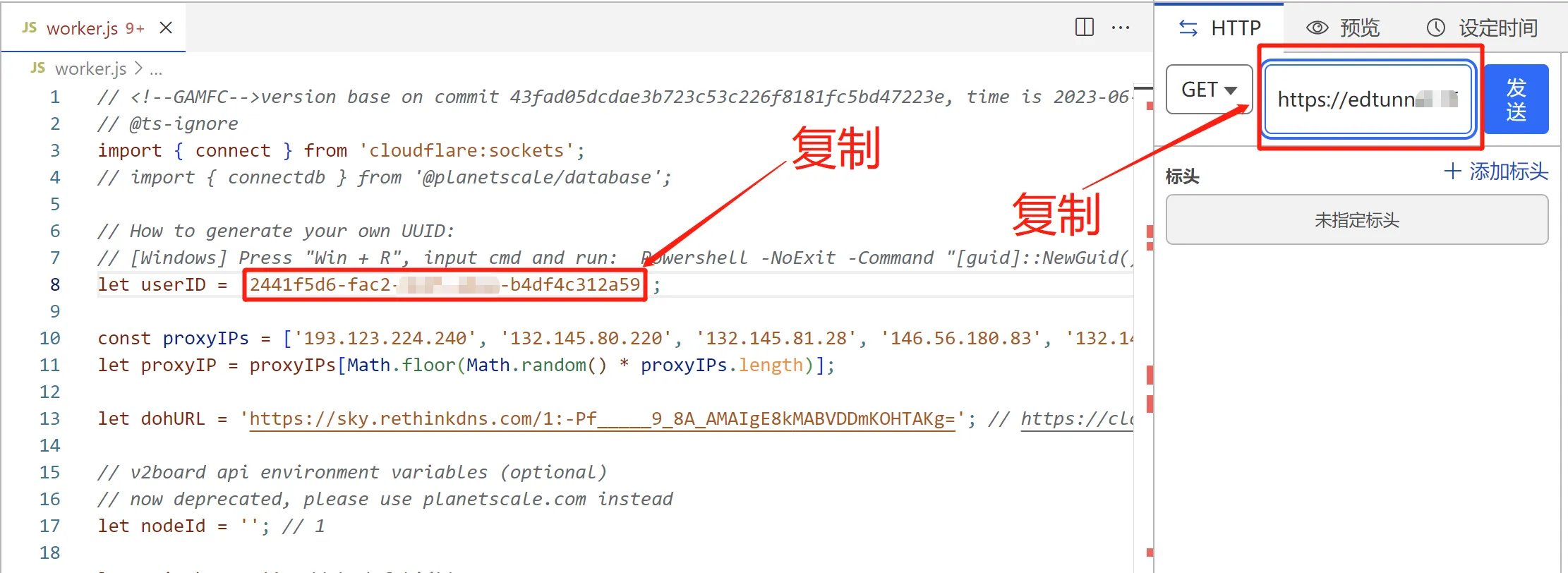

这里我要补充一下,如果你在没有其他科学上网节点的辅助下,这个链接你是打不开的。所以,我强烈建议大家配置自己的域名,只有配置了自己的域名才能不借助其他科学上网的情况下,获取到我们搭建的免费节点。(如何配置域名请继续往下阅读)
2、将下方vless节点链接,复制到v2ray等代理软件里。


3、把节点复制进来之后,再测试一下节点是否联通。我用的是v2rayN,不知道在哪里下载的小伙伴请点击这里。
官方下载地址:https://github.com/2dust/v2rayN/releases/download/6.29/zz_v2rayN-With-Core-SelfContained.7z
官方下载个能会很慢,请自行在浏览器扩展里安装油猴插件,搜索并安装GitHub下载加速脚本。
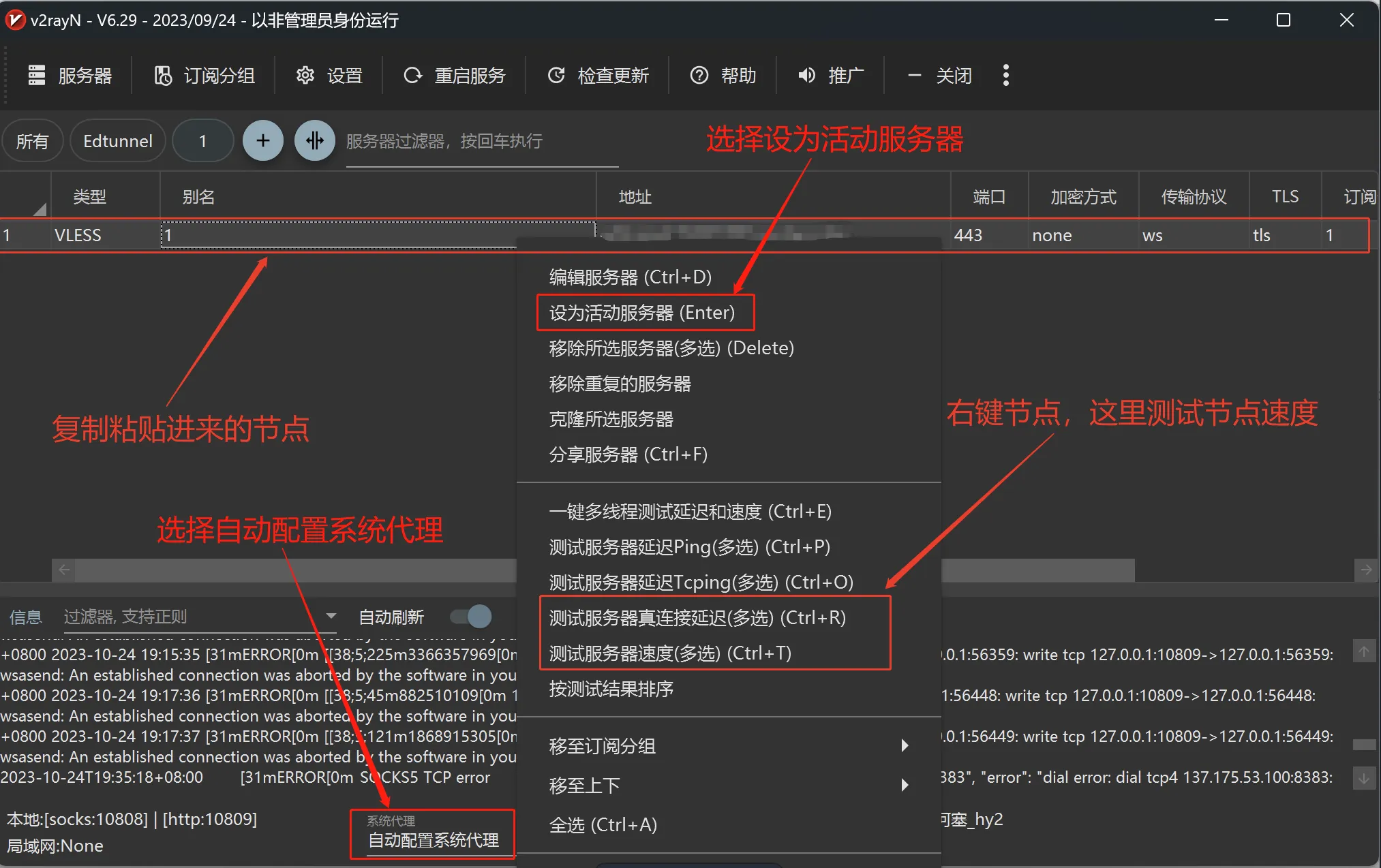
四、配置域名(非必要)
对于有些小伙伴来说,完成了以上步骤,能正常实现科学上网就满足了,但是对于一些有进一步需求的小伙伴来说,能科学上网还不够,还要能安全的科学上网。那么,我们就来给节点自己搭建的项目套上一件马甲(域名)。域名虽然不是必要的,但是我还是希望各位小伙伴能配置自己的域名。
首先,返回到 概述 页面,点击我们搭建的应用。
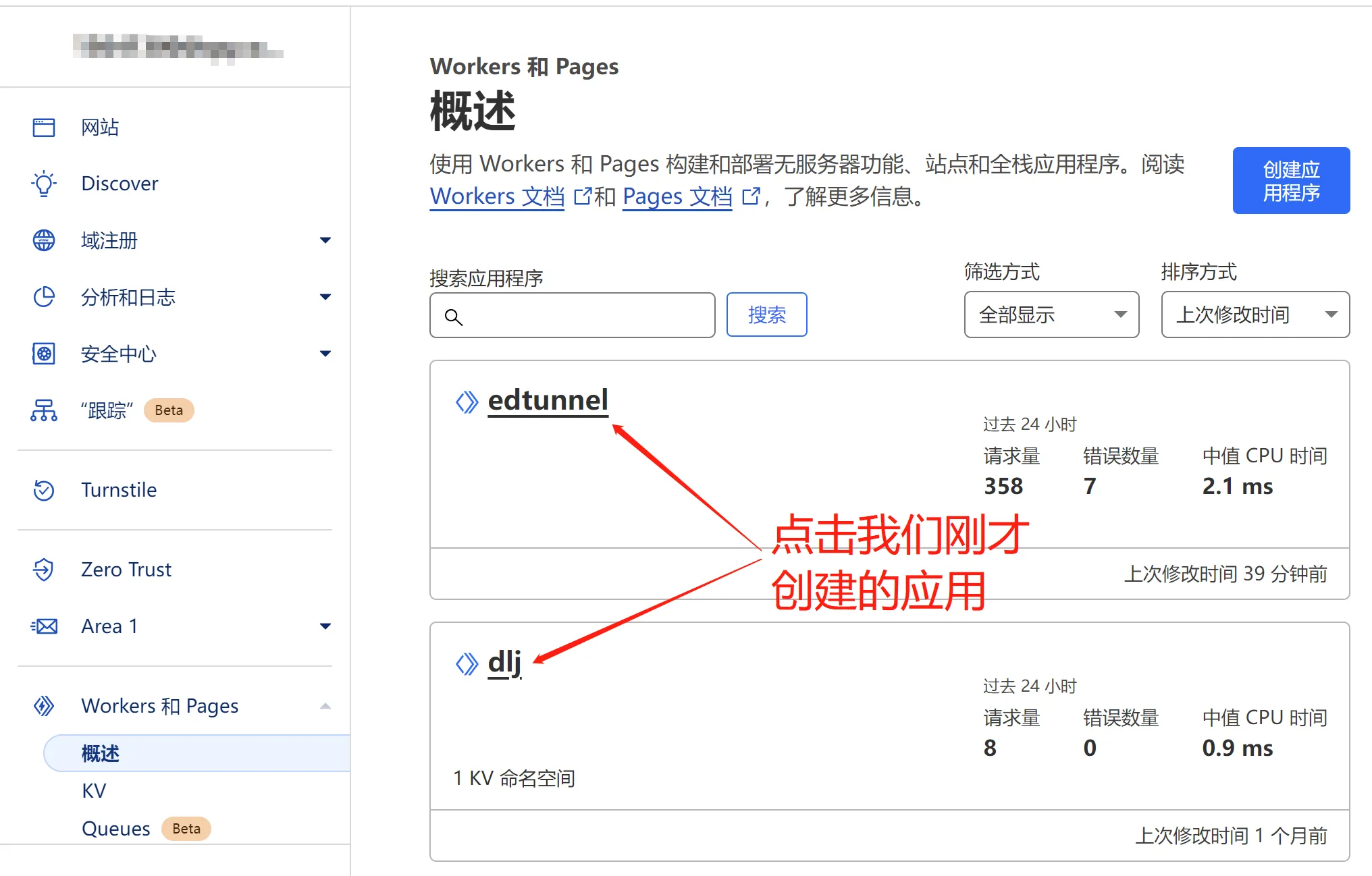
进入到应用之后,找到 Custom Domains 点击 查看 ,然后再点击 添加自定义域 输入自己的域名,我这里以eu.org域名为例,例如: xxx.xxx.eu.org ,然后等待证书生效,域名就配置完成了。
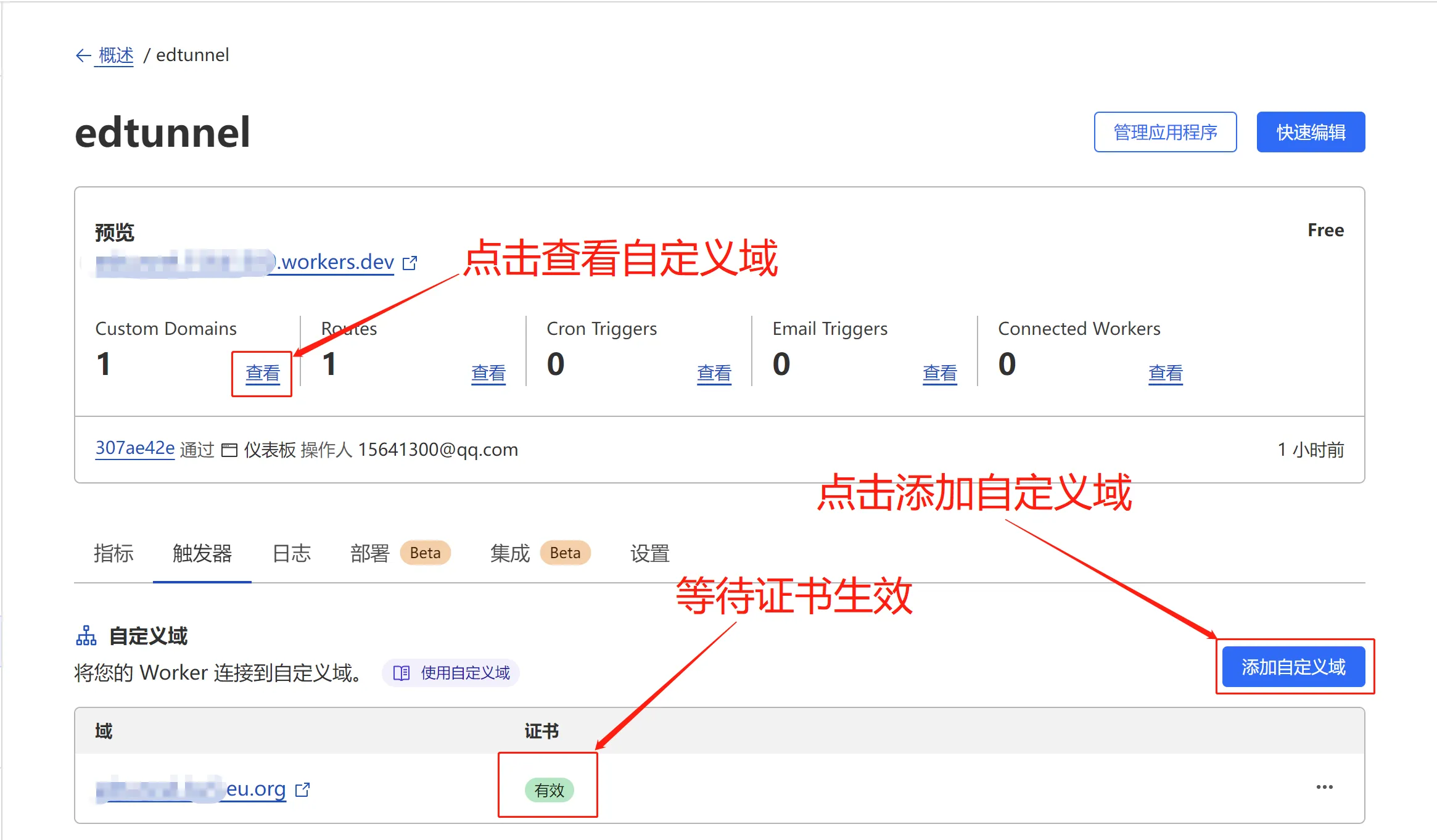
完成之后,你就可以用 域名/UUID 的格式获取到你自己搭建的节点信息了,从一定程度上提升了节点使用的安全性。
结语
到这里不出以外的话,你已经能打开Google了,现在我们还没有做反代IP的优选,速度上可能还不忍直视,不管怎样第一步我们算是迈出去了,打开了与世界连接的新大门。下一篇文章我们就来说一说如何进行反代IP的优选,请拭目以待。






评论区